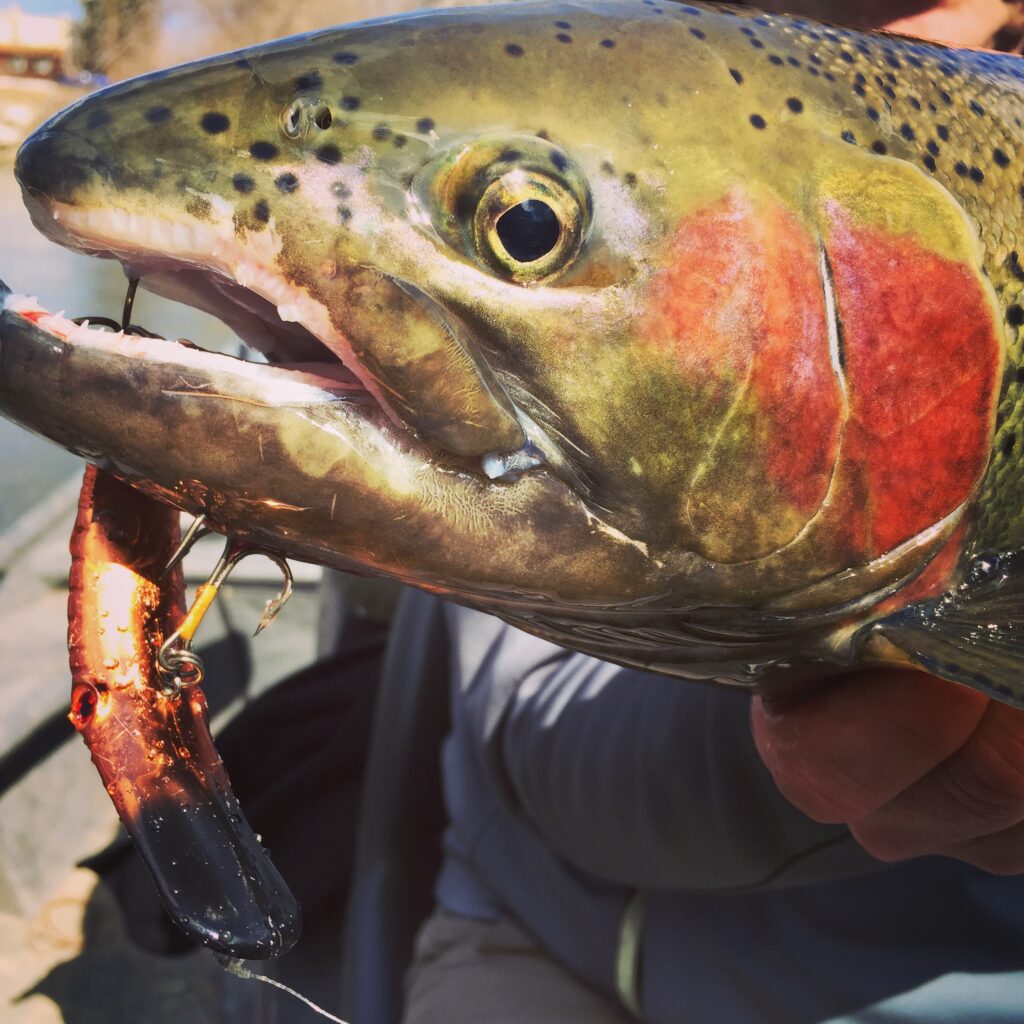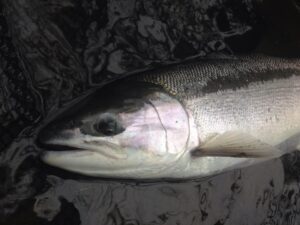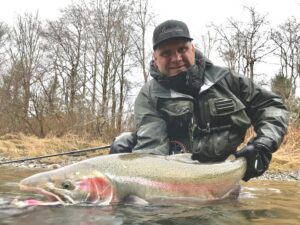
Ask any old timer that’s been Steelhead fishing for any given length of time and they will tell you stories about a method that has been around for a while and it has many names. Names like back trolling, pulling plugs or hot shotting just name a few. I call it the Plug Pulling Boogie! It’s a technique where crank baits, i.e. (plugs) are set behind the boat with 4 rods. Either staggered, or the exact same distance creating a wall of plugs often referred to as the curtain or wall of death. Just for the record, this slang term does not mean all fish die or are harvested.

Many plug pullers are like hunters hunting with dogs it’s all about seeing the dog work. In this case, it all about the strike or the takedown. I’d rather sit and watch a rod buckle all day than even reel in the fish. The takedown is savage like and ferocious! When the steelhead has had enough and snaps it’s time to crush the invader and it’s no joke. What makes this technique so deadly, the reasons are many. First, the theory is the fish are pushed around the hole and as the boat slowly moves down the run the fish keep getting pushed back to the back of the run. Once they get to the last 1/3 or so of the hole they strike the plug out of sheer anger because they do not want to leave the security of the water they have chosen to hold in. Remember these fish are used to cold, dark, deep water either in the Great Lakes or Ocean. Also, steelhead are very territorial creatures and a plastic wiggler presented slow and low in their face drives them crazy. What’s great is, it doesn’t matter the mood of the fish so to speak you’re forcing the fish to bite by invading their space. As we get into this deadly technique I will list some tips to get you started in the right direction or if you’re a season puller I hope to make you a better plug fisherman.
The Right Rod
You first should start with the right gear. The rod is so very important in this game. It’s all about the wiggle of the plug. If the plugs are not dancing at the party equals no fish. The plugs must dive and wiggle to get in the fish’s face. Thousands of dollars are spent on the engineering of these plugs and if you’re using too stiff of a fishing rod it inhibits the action of the plug.
Most serious plug pullers prefer a one-piece rod that’s short in the steelhead world. Most are 7 ½ – 8 ½ feet in length and it’s crucial the rod be a fast action with a soft tip. I tried many rods over the years but my most favorite are the Lamiglas Certified Kwik Pro Series in the XCC 801 or 802. This rod has been around a long time and is a great investment. You spend lots of money, travel expenses, tackle, etc.… don’t skimp on the rod it WILL catch you more fish. If your budget does not allow, check out the Lamiglas X-11 LX86 series. Great bang for the buck. What these rods do for you is allow the plugs to set up in the run, dig and work. When the strike occurs because of the soft, fast action tip the fish does not feel a stiff rod and let go of the invader. Once they crush the plug and turn its time for my two favorites. FISH ON! So, the right rod allows you to get the maximum wiggle out of the plugs and then helps you when it’s time for the hook ups.
Certified Kwik Pro Series XCC 801 or 802

X-11 Rods

Line Choices
Now, this segment is just my opinion on fishing line. Do what you feel is best. Over the years, I have discovered line choices are a personal and confidence thing. Out west most love to use high viz braid. And it works great out there. However, the choice in the great lakes is mono. Due to freezing temperatures. Now, some in the great lakes region will use braid with a long mono bumper. It does work but my preference is mono. Most are fish are caught in 4-8 foot of water.
I love high viz mono like Suffix Siege in tangerine orange, in either 14lb or 17lb test. This line has a patented abrasion resistance and provides tough-as-nails durability, with near zero memory. First, the mono has stretch, where braid does not and gives the fish more time to make that turn with the plug without resistance. Second, because its high viz you can see where each line is. If a plug gets fouled with debris and starts to slide over you can quickly grab the rod out of the holder and clear it before it makes a mess. Also, other anglers on the boat can visually see where the lines are at when fighting a fish and steer the fish clear until the other rods are cleared to allow the fish to be landed. Lastly, mono is cheaper than braid and does not absorb as much water and will not freeze.
Fluorocarbon
Do yourself a favor and splice in a fluorocarbon leader. I generally use a leader that’s 5-8 foot in length depending on flow and water clarity. It is imperative when fishing smaller plugs in the 3 – 3.5-inch range such as the Yakima Mag Lips not to make the leader too heavy. I run a maximum 10-12 lb. test leader. Anything above that and you impede the action of the plug due to the line diameter and resistance. Great Lakes Anglers fish very low, clear water in the winter. The fish hold in slow deep pools so they need all the wiggle and depth they can get.
Reel Choice
My favorite reels to use for plugging is a Shimano Tekota 300LC. I prefer a line counter reel so I always know how far back my plugs are from the boat. It’s a nice feature but not necessary if your budget doesn’t allow. You can simply count the passes of the reel to get an idea how far back you are. Or another great trick is to add a fluorescent colored string bobber stop. Measure out thirty or forty feet and cinch down, trim some of the tag ends off and add a drop of fly head cement to lock into place. Depending on what river I’m fishing and the current flow, most of the time my plugs are the exact same distance from the boat. The line counter reels just make it easier to make adjustments and know where you’re at all times. Please remember to engage the drag on your reels and check them. My recommendation to set you’re drags light so the fish has room to run and turn. You can always adjust drag once the rod is in your hands to land the fish. Remember if you follow my advice on leader size the drag should be set at a 1/3 or ¼ breaking strength of the leader. Use a scale to be precise if needed. The drag is important it helps prevent break offs and to tire the fish quickly.
Shimano 300LC
The Right Snap
Most plugs come with a factory snap or a split ring depending on the style and brand of plug. The plug was designed and tested to use that snap it comes with and the stock snap performs very well and should be used most of the time. What needs to be avoided is using a regular snap swivel. That’s a big no-no. Plugs are made to wiggle, not spin, but I see this on the river all the time.
Now here are some tips to get you more wiggle out of your plugs in slower water or current. First, you can double up the factory snaps and instantly give the plug more wiggle which is great when fishing very slow water. Next, you should consider using a VMC crank Bait snap. This snap was designed for the Bass guys and is incredibly strong. It has a wider tear drop shape that allows the plug to wiggle more. I have scoured the internet to see if any steelhead fisherman has been talking or writing about using this using this snap for plugs. I could not find anyone at the time of this post. So remember you heard it here first. Trust me it works great in slower water and makes the plug dance. My favorite sizes for smaller plugs in the 3-3.5 range are size zero or size 1. Lastly, make sure the snap is facing up. If not, while fighting the fish the upturned part of the duo lock snap can get hung up on the bill of the plug and come open. As you can see the snap is a very important piece of equipment.
Snap is facing down
How Far Back?
How far back, number one question I get while doing seminars. It’s a great question but there is no one certain distance for every situation. It depends on the river, current speed, depth and clarity, to name a few. I have fished them anywhere from 15 ft. – 60 ft. back depending on the conditions. But a good rule of thumb is 40 feet from the boat. If your fishing slower water or water that’s very clear you’re going to need the plugs further away from the boat. This is needed to get the plugs down and keep the boat from not spooking fish.
A good plug puller will have the plugs put out well upstream of the run and get in position. The plugs must be the right distance from the boat and working properly when they drop into the run to be fished. During high water the fish will be setting high in the run. Low water they will be setting at the back of the run. If the fish are fresh or feeding they will be at the top. Lastly the leviathan toad that your seeking most times will be setting in the middle of the run in a prime rest lye. Only to be pushed back to the last third of its hideout before crushing the plug. Bottom line the plugs must be diving and fishing before you get into the run to insure it was covered properly. I see too many folks on the river that stop on top of where the fish are holding. In my opinion I believe the biggest fish every year come on plugs.
Speed of the Plug
I can sum this tip up very easily. Slow and low, that’s it. Move through the run slowly. If you go through the run too fast the plug is looked at as a passerby fish. Think about what I’m saying those fish are sitting there facing upstream in the current and see fish pass by all day every day. If the bait is put in their space and agitate them your more apt to get a bite. Remember each plug has a minimum and maximum running depth. Most steelhead are caught in 4-8 foot of water. If your fishing a run that’s really deep you might need to rethink the plug choice. To ensure the bait will be in the strike zone. There is times and places where plugs presented above the fish’s heads produce results but that’s another article for another day. Popular baits folks like to use are 2.5 – 3.5 inches in the world of steelhead. Hot Shots, Kwik Fish, Brads Wigglers and Wee Wigglers to name a few. The Yakima Mag Lips in those stated sizes are also great choices. This tip is simple to remember slow and low and that should produce you some fish.
In a future post, I will get into styles and actions of the plugs and what colors work best. A fascinating subject in its self. I hope you have learned a few tips and tricks on gear and plug placement. If you have never tried plug fishing you’re really missing out. There are days that it cannot be beat. Everyone is entitled to an opinion but no one is entitled to the facts. Ask any veteran in the world of Steelhead and I’m sure they will agree. Pulling plugs has a solid place in steel heading world and is only growing in popularity every year. Give plugging a try one savage take down and the fish isn’t the only thing that will be hooked.
Tight Lines!


Very effective way to catch steelies